Mishandling Of California Fires Cause State Regulators To Propose Breaking PG&E Into Pieces (#GotBitcoin?)
PG&E faces billions of dollars in legal claims, the specter of bankruptcy, a federal judge forcing his way into utility operations, the possibility state regulators will break it into pieces, and potential state criminal charges including homicide, due to its continued inability to stop the fires from starting. Mishandling Of California Fires Cause State Regulators To Propose Breaking PG&E Into Pieces (#GotBitcoin?)
The Golden State’s largest utility has struggled to reduce fire risks as its equipment keeps igniting blazes.
PG&E Corp. equipment started more than one fire a day in California on average in recent years as a historic drought turned the region into a tinderbox. The utility’s unsuccessful efforts to prevent such blazes have put it in a state of crisis.
The fires included one on Oct. 8, 2017, when nearly 50-mile-an-hour winds snapped an alder tree in California’s Sonoma County wine country. The tree’s top hit a half-century-old PG&E power line and knocked it into a dry grass field, a state investigation found. The line set the grass ablaze, sparking what became known as the Nuns Fire.
It was among at least 17 major wildfires that year that California investigators have tied to PG&E. Data from the state firefighting agency, Cal Fire, show the fires together scorched 193,743 acres in eight counties, destroyed 3,256 structures and killed 22 people.
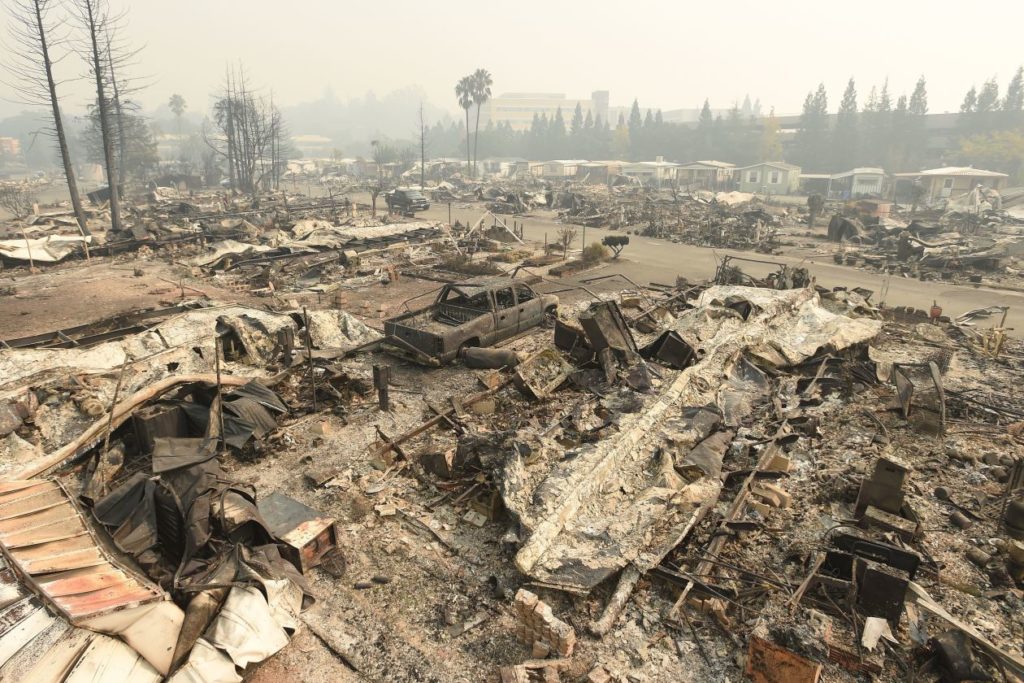
California’s largest utility, with a history of safety and maintenance problems, has been scrambling for five years to reduce fire risks. It has been overwhelmed by the threat’s severity and the challenge of shoring up thousands of miles of aging power lines and cutting and trimming millions of trees in a service area larger than Florida, according to a Wall Street Journal review of court records, regulatory filings and interviews with current and former regulators and company employees.
Sunday evening, the company announced that Chief Executive Geisha Williams was stepping down and that John Simon, the company’s general counsel, would serve as interim CEO until a replacement is found.
“It’s an organization facing collapse,” said Arthur O’Donnell, a safety supervisor at the California Public Utilities Commission until late last year. “There aren’t any silver bullets that can fix things quickly.”
California Tinderbox
PG&E power lines and other equipment have led to more than 1,500 fires in the past few years, several of which have grown large due to the region’s dry conditions.
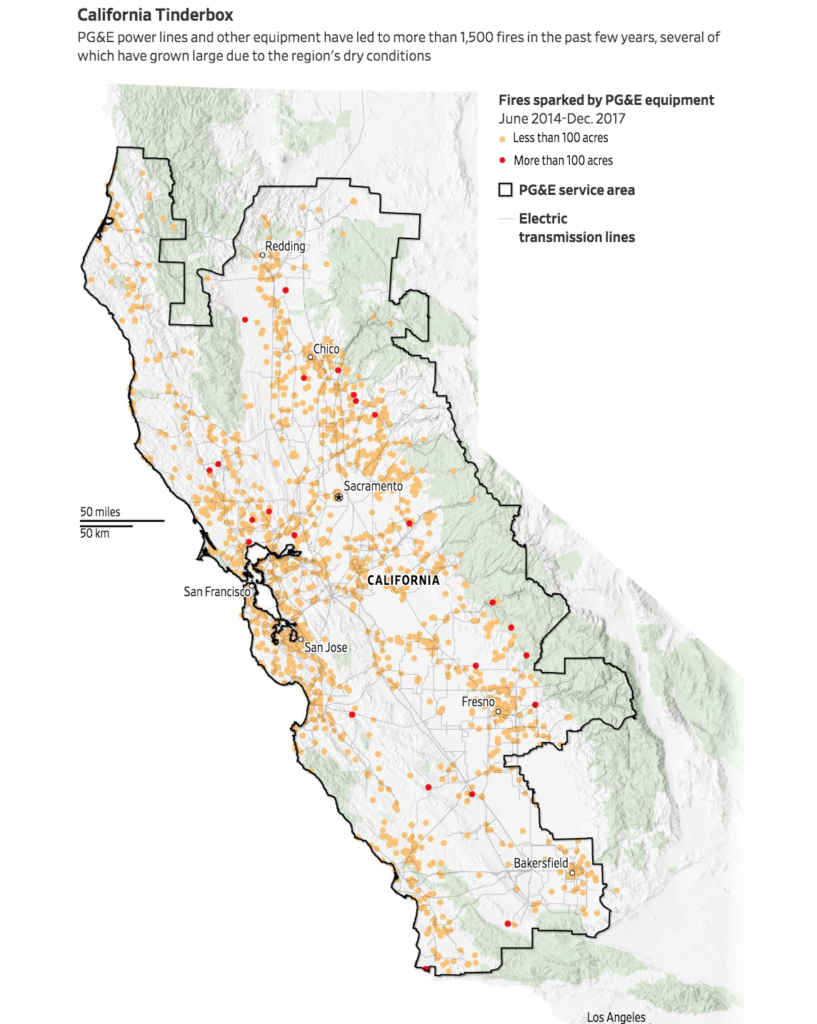
The decade’s drought was unprecedented, bringing fire risks few in California had experienced. As conditions became more conducive to massive fires, the utility and its power lines kept providing sparks. PG&E spent heavily to make its system safer but couldn’t prevent an increase in fires.
PG&E didn’t anticipate how quickly the drought would overtake heavily wooded areas north of San Francisco and outside Sacramento, said Stephen Tankersley, who oversaw PG&E’s vegetation-management program between 1999 and 2015. “It’s hard to believe that anybody would have predicted that it would have been like this,” said Mr. Tankersley, now a utilities consultant. “I’ve never seen anything like it.”
Conditions on the ground worsened dramatically and quickly, said PG&E spokeswoman Lynsey Paulo. She said the utility has reacted with speed and urgency. “We are very aware of the risk and we are doing everything we can to keep our customers and the communities we serve safe,” she said. “PG&E considers wildfire risk as a top-tier enterprise risk. It is evident in our actions.”
The utility removed 451,000 more trees from 2016 through 2018 than it had originally forecast, she said, in an “amped up” effort to deal with massive tree mortality.

“We aspire to have absolutely no wildfires,” Ms. Williams said during a 2017 deposition in a lawsuit seeking fire-related damages from the company. She said operating thousands of miles of electrical conductors through forests created “an inherent exposure.” PG&E declined to make her available for an interview.
The number of fires PG&E reported its equipment sparked has risen in recent years even as it has stepped up spending on tree trimming and fire reduction programs. The state required it to report fires beginning in June 2014. It has since disclosed its equipment started about 1,550 fires through 2017. While most are snuffed out within minutes, some stoked by winds have spread quickly.
PG&E executives tried to assure investors, politicians and the public last year that the company, which provides natural gas and electricity to 16 million people, was getting the wildfire threat under control. Then in November, another tore through the town of Paradise, Calif., killing 86 people and destroying about 14,000 homes.
California officials have yet to determine the cause of that blaze, the Camp Fire, the deadliest in state history. PG&E has disclosed a 115,000-volt line was damaged and dislodged from one of its towers in the area some 15 minutes before the fire was first reported.
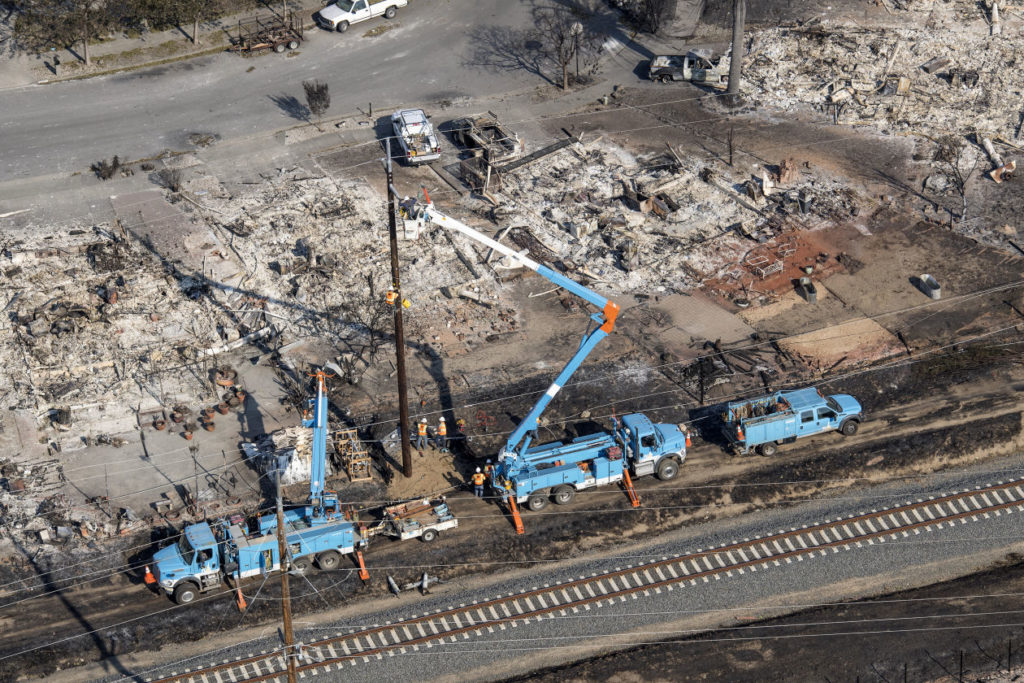
PG&E faces dozens of lawsuits from residents and insurers demanding it pay for fire damages. California law makes utilities responsible for any fire started by their equipment, even if they weren’t negligent. Analysts have pegged PG&E’s wildfire liabilities as high as $30 billion. That is triple its market value of $9.12 billion, which has plunged from $25.32 billion in mid-October. The S&P Utilities index has fallen 0.8% over the period.
Credit agencies have downgraded PG&E and have raised the possibility of bankruptcy along with regulators, legislators and analysts, citing the huge liability sums the company could face and the souring relationship between the company and California politicians. State lawmakers passed legislation last year to help shield the company from the prospect of bankruptcy after the 2017 fires by letting it pass some liability costs on to ratepayers. But the measure didn’t explicitly address fires in 2018. Now public opposition to PG&E has grown, complicating the prospects of any new political rescue.
Bankruptcies of regulated utilities are rare because their revenues are largely guaranteed by state and federal regulators. There haven’t been utility bankruptcies in significant number since the 1980s, when there was fallout from canceled nuclear power plants. PG&E’s Pacific Gas & Electric unit underwent bankruptcy reorganization from 2001 to 2004, as a result of the California energy crisis—the only utility in the state to take that step.
The California Public Utilities Commission and state lawmakers are debating proposals to let PG&E turn much of the fire-related obligation into securitized debt, which businesses and homeowners would pay off over many years through their power prices, already some of America’s highest. Regulators are exploring whether PG&E could be split into separate gas and electric businesses or into smaller regional utilities.
The California attorney general’s office recently said the company could face criminal charges, including manslaughter, in connection with fires, depending on the outcome of investigations. PG&E is on federal criminal probation resulting from felony convictions stemming from the 2010 San Bruno natural-gas-line explosion that killed eight people—it pleaded not guilty—and has a federally appointed monitor reviewing its gas safety practices.
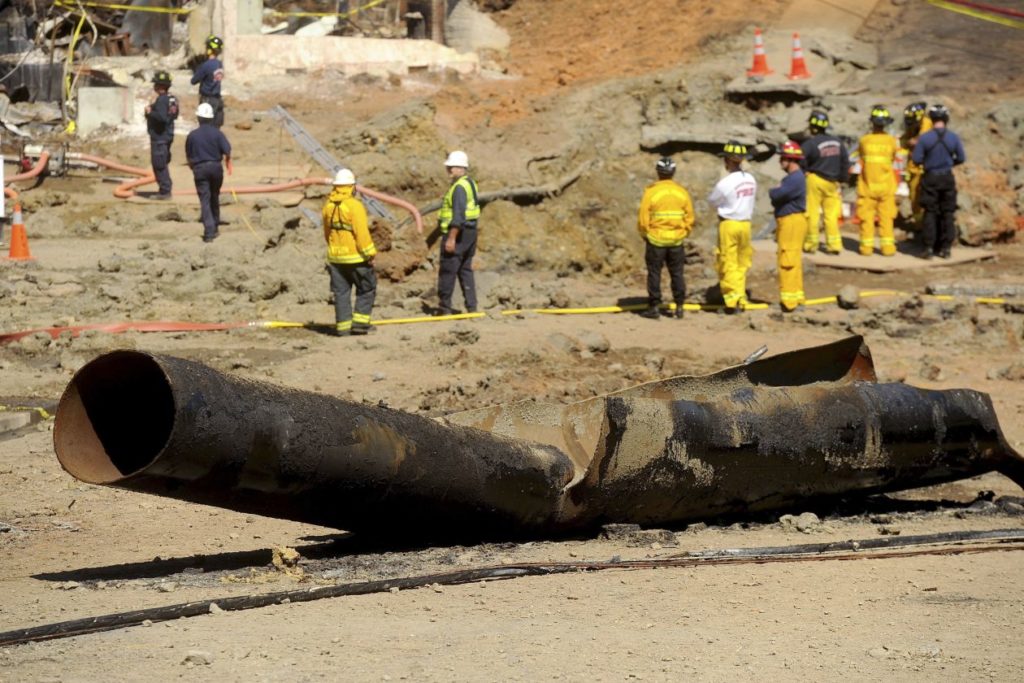
U.S. District Judge William Alsup is considering whether PG&E may have violated the terms of its probation due to the fires. This month, he also proposed forcing PG&E to turn off power in fire-prone pockets during high-risk periods, saying “that inconvenience, irritating as it will be, will pale by comparison to the death and destruction that otherwise might result from PG&E-inflicted wildfires.” PG&E has until Jan. 23 to respond and declined to comment.
Surviving San Bruno’s fallout was a driving focus of company leaders for years, distracting it from the emerging wildfire threat, said Paula Rosput Reynolds, chairwoman of an independent panel that investigated PG&E after the explosion. “They lurch from crisis to crisis,” she said.
PG&E faced two challenges as drought took hold. It needed to update many of its 125,000 miles of electrical lines—enough to wrap the equator five times. From 2013 through 2017, it reported more than 16,000 sections of high-voltage lines fell. That is one downed line every three hours. PG&E reported that most dropped because trees fell on them but that many tumbled due to equipment failures. PG&E estimates about 30% stayed energized—creating fire or shock risk.
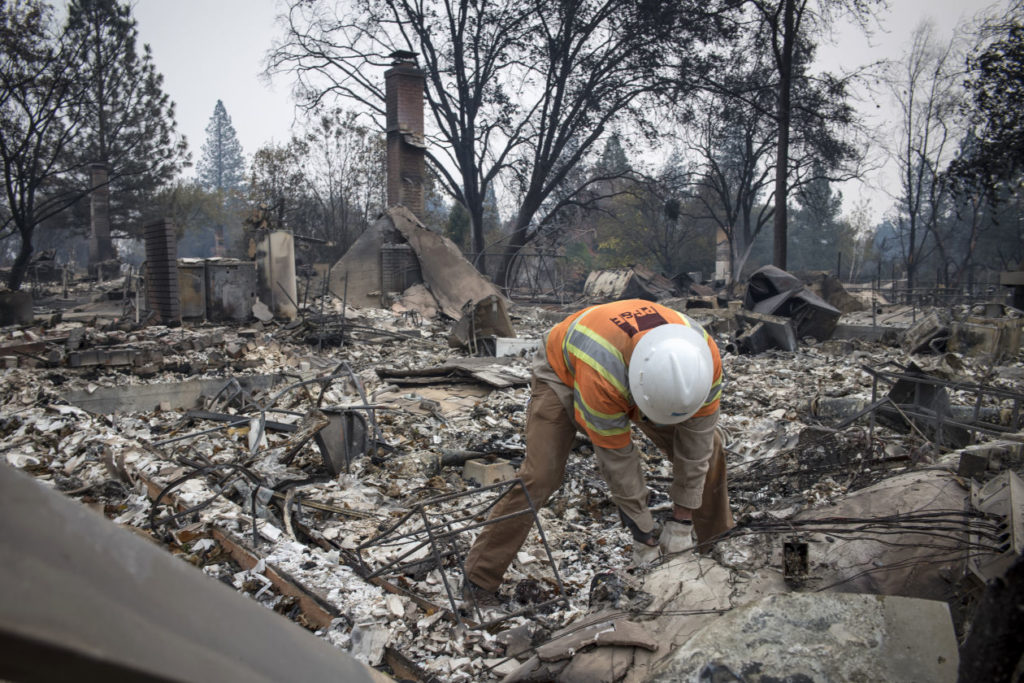
It also faced a massive tree-clearing campaign. It estimated in January 2018 that there were 120 million trees that could come in contact with its power lines and set out to trim 1.4 million annually.
It had problems finding skilled workers to do the job. Between 2014 and 2016, it let one contractor lower its hiring requirements because of a shortage of qualified workers, according to a deposition of the contractor’s operations manager taken as part of a wildfire lawsuit.
The task was complicated because some dangerous trees were on private land, forcing PG&E to negotiate with landowners, said Bob Fratini, a retired PG&E vegetation-management manager. Residents sometimes pressured crews, he said, to trim just enough to satisfy minimum requirements.
“Utilities should be given the right to remove any tree that could cause an outage or a fire,” he said. California regulators recently gave utilities more latitude in this area, saying they could shut off power to homes or businesses that prevent tree crews from working. PG&E’s Ms. Paulo said that isn’t necessary very often.
Sometimes, PG&E’s tree-clearing created new problems. After PG&E workers removed two trees in January 2015 southeast of Sacramento, a gray pine was exposed to wind and began leaning, according to a state investigation.
On a 102-degree day in September, the pine hit a 12,000-volt line and electricity ignited it, dropping embers onto dry grass and sparking the Butte Fire, which burned 70,868 acres and 921 buildings. Two people died.
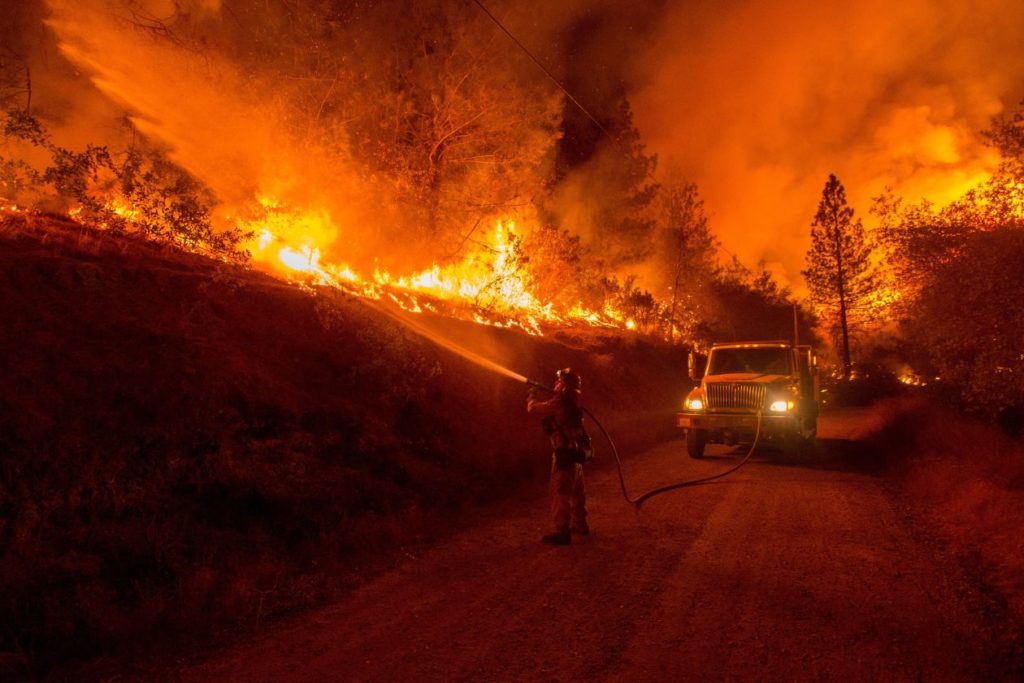
A Firefighter Battles The Butte Fire Near San Andreas, Calif., September 2015.
In 2016, PG&E spent $435 million on a one-year blitz to clear dead trees hit by drought and beetle infestation, and $300 million more on other wildfire-related measures.
Since 2010, state inspectors assigned to audit PG&E’s electric operations have consistently found that the company completed maintenance and repair work behind schedule.
Wildfires returned with a vengeance in 2017. PG&E voiced optimism it was getting the situation under control. Weeks after the 2017 fires, it filed a 660-page report with state regulators describing wildfires as its fifth-most-significant safety risk, behind factors such as employee safety. PG&E’s Ms. Paulo said that the exact rank wasn’t important. “What is important is that top enterprise risks like wildfire are receiving focused attention,” she said.
“They never understood the risks,” said state Sen. Jerry Hill, a longtime critic of the company’s safety record. “They missed it in San Bruno and missed it with the wildfires. They didn’t have a clue.”
For years, PG&E and state officials assumed the company’s fire risks were less severe than those of utilities in Southern California, where hot Santa Ana winds had historically posed a threat in autumn.
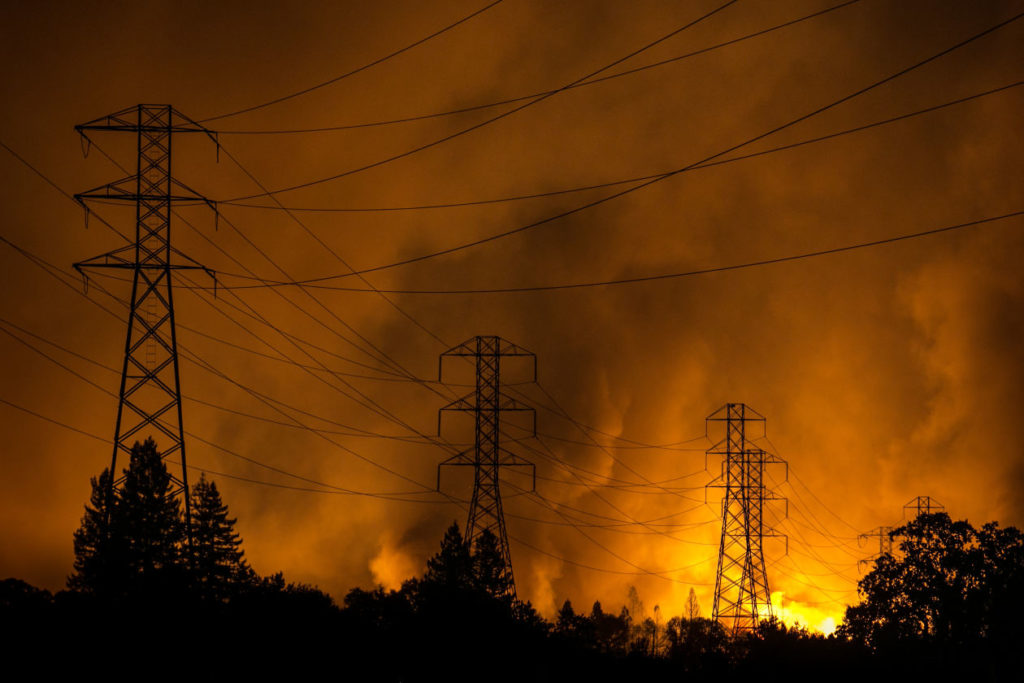
Now it was clear PG&E faced a similar danger in what state officials concluded was the manifestation of climate change. And a growing population shift to Northern and Central California woodland areas had put more people in harm’s way.
Two big Southern California utilities, Sempra Energy ’s San Diego Gas & Electric and Edison International ’s Southern California Edison unit, encouraged by state officials, had installed weather stations to track regional wind conditions and developed policies to proactively turn off electricity in areas with especially high fire risks. PG&E, which state officials hadn’t pushed to do the same, was far behind in these measures.
After a deadly 2007 fire, San Diego Gas & Electric replaced 16,000 wood poles with steel poles, selectively insulated wires and widened gaps between wires, building a system to withstand 85 mile-an-hour winds. It has spent more than $1 billion so far, said a utility spokeswoman, and is still implementing the changes.
PG&E filed a request with state regulators last month to spend $5 billion from 2018 to 2022 to reduce fires by accelerating plans to insulate wires, replace power poles and towers, install safer equipment and cut down trees.
It is proposing to install technology that better allows engineers to automatically shut down equipment when fire risks are highest. It plans to install 600 smoke-spotting cameras to provide early fire warnings, up from nine currently installed, and add 1,300 local weather stations. PG&E estimates most of the proposed changes won’t be completed until 2022, raising the prospect fires could continue for the next few years.
For Californians like Mike Holdner, trust in PG&E has eroded. Mr. Holdner, whose home burned down in the 2017 Tubbs Fire that killed 22 people, said he is considering suing the utility if a state investigation determines its equipment started the fire. “If it puts them into bankruptcy, so be it,” he said, “if that’s the way you have to change that culture.”
Updated: 10-9-2019
Power Outage In California Affects Millions As PG&E Tries To Avoid Wildfire
Seeking to limit fire risk amid high winds, PG&E cuts electricity across Northern California.
PG&E Corp. began cutting power to nearly a million households and businesses across California early Wednesday, in an unprecedented move to help lower the region’s wildfire threat in the face of the kind of windstorm that previously fueled disastrous infernos.
The bankrupt utility said it began implementing the first phase of what it calls public-safety power shut-offs shortly after midnight, affecting about 513,000 customers in 22 counties stretching from Marin, Sonoma and Napa, north of San Francisco, to the Sierra Nevada foothills.
PG&E said the second phase of the shut-off would begin at noon to about 234,000 customers in seven more counties, including cities such as Oakland, Berkeley and San Jose. A third phase was being considered for 42,000 customers in Central California, the company said. With multiple people in many households, the blackouts could affect millions of people.
The move came after the utility had warned for days it planned to cut power to hundreds of thousands of residences and businesses as strong, dry winds were forecast to hit Northern California, increasing the risk that its equipment could start fires. The winds remained largely calm Wednesday morning, but were forecast to begin gusting later in the day.
PG&E dramatically expanded the use of public-safety power shut-offs earlier this year in a bid to prevent its power lines from igniting dry brush on windy days. Its equipment sparked 19 major wildfires in 2017 and 2018 that collectively killed more than 100 people and destroyed thousands of homes. The company sought bankruptcy protection in January, citing more than $30 billion in potential fire-related liability costs.
PG&E officials said late Tuesday they anticipated the winds to slow by midday Thursday, but warned it could take another three days or longer to fully restore power due to the time needed to inspect all the lines affected by the shut-off.
“We very much understand the inconvenience and the difficulty such a power outage would cause,” said Sumeet Singh, vice president of PG&E’s community wildfire safety program. “We do not take or make this decision lightly.”
Updated: 10-19-2019
PG&E CEO Says It Could Impose Blackouts in California For A Decade
Bill Johnson makes the disclosure in a hearing at which California officials blast PG&E’s shutoffs this month.
PG&E Corp. ’s chief executive said Friday that it could take as long as 10 years for the company to improve its electric system enough to significantly diminish the need to pull the plug on customers to reduce the risk of sparking fires.
Bill Johnson, who joined the company in May, made the disclosure at a California Public Utilities Commission hearing where the panel’s president, Marybel Batjer, sharply criticized the company’s “inadequate execution” of a shut-off in which it turned off power to large portions of Northern California for more than two days last week.
The commission convened an emergency meeting to examine PG&E’s handling of the massive blackout, which left roughly two million people in the dark and created widespread havoc from the Bay Area to the northern reaches of the state. Several of the company’s top executives were summoned to detail the problems and take questions from regulators.
“I can tell you that you guys failed on so many levels on fairly simple stuff,” Ms. Batjer said.
The agency earlier this week ordered PG&E to address numerous problems with its strategy for such blackouts, known as public safety power shut-offs. It condemned the company’s failure to provide maps and other critical information to residents and local officials ahead of the shut-off. PG&E’s website crashed for two days during the blackout, and its call centers were overwhelmed.
Mr. Johnson on Friday apologized for the hardships caused by the shut-off but defended the company’s decision to implement it, noting that none of its power lines sparked fires, even though strong winds in certain areas caused damage to its system.
“Making the right decision on safety is not the same as executing that decision well,” he said. “PG&E has to be better prepared than it was this time.”
PG&E, which provides gas and electricity to 16 million people, shut off the power to more than 700,000 homes and businesses in anticipation of strong winds that could have increased the chances of its power lines sparking fires. The company’s equipment has sparked 19 major fires during windy periods in 2017 and 2018, mostly because vegetation blew into live wires.
PG&E isn’t the only California utility to deploy shut-offs to mitigate wildfire risks. Edison International’s Southern California Edison and Sempra Energy’s San Diego Gas & Electric also cut power recently in response to windy conditions. But PG&E is the only U.S. utility to have initiated a weather-related blackout on such a large scale.
The decision drew the ire of legislators and local officials who have called on PG&E to act more prudently in enacting future shut-offs. A group of Northern California governments, including Napa and Sonoma counties, on Thursday filed a scathing brief with the utilities commission that berated PG&E for its lack of preparedness.
“The experience of working with PG&E to effect real changes to its de-energization program has been like battling the Hydra,” it read. “This has got to stop.”
For now, the shut-offs will continue as PG&E scrambles to trim trees near power lines and upgrade equipment across its 70,000-square-mile service territory, after a protracted drought this decade turned millions of acres of forest into a tinderbox.
Another major fire tied to PG&E’s equipment would likely drive the company to insolvency. It sought bankruptcy protection in January, citing more than $30 billion in liability costs stemming from the 2017 and 2018 fires, which collectively killed more than 100 people.
At the meeting Friday, commissioners questioned the company’s commitment to its customers and how long it anticipates deploying its shut-off strategy on such a large scale.
Mr. Johnson said the utility is working to limit the scope of future shut-offs by trimming more trees and installing technology to enable the shutdown of smaller, more targeted portions of the grid. But he estimated it will take as long as a decade before its shut-offs will have “ratcheted down significantly.”
“I think they’ll decrease in size and scope every year,” he said. “But at the same time we’re doing this the risk is not static, it’s dynamic and it goes up every year.”
Already, PG&E is behind on several of its most important safety efforts, records show, including this year’s tree-trimming campaign, which is less than 50% complete. It also trails its peers in technology to track winds and isolate the areas where equipment is at highest risk of sparking fires.
Though the company warned of continued shut-offs, it is working to limit their duration.
Michael Lewis, PG&E’s senior vice president of electric operations, said the company, which previously advised customers to prepare for shut-offs lasting as long as five days, will work to restore power within 48 hours after initiating a shut-off.
“We now recognize that five days as a benchmark is unacceptable,” he said.
Updated: 11-5-2019
California Mayors Join Campaign to Buy Out PG&E
Leaders of more than a dozen cities, including Oakland and Sacramento, back proposal to make the utility customer-owned.
The mayors of Oakland, Sacramento and more than a dozen other California municipalities are joining San Jose in a campaign to buy out the investor-owned PG&E Corp. PCG 8.94% and turn it into a giant customer-owned cooperative.
The idea, first floated last month by San Jose Mayor Sam Liccardo, is winning support from mayors and county officials who represent nearly one-third of the population served by PG&E’s utility subsidiary, Pacific Gas & Electric Co.
The coalition is asking the California Public Utilities Commission and Gov. Gavin Newsom to consider the option seriously before the state approves any bankruptcy reorganization plan. PG&E filed for chapter 11 protection in January, citing an estimated $30 billion in wildfire liabilities.
By law, the utilities commission must determine that any plan approved by a federal bankruptcy court is in the public interest before it can be implemented. That is why the coalition is seeking to persuade the commission and state leaders that their idea has merit.
PG&E has adamantly opposed the sale of any part of its system. Chief Executive Bill Johnson last month rejected an offer by San Francisco to buy the portion of PG&E’s electric network that is within city limits for $2.5 billion. The company has also said it isn’t interested in being converted into an electric and gas cooperative—an idea known as mutualization, which would transfer ownership from investors to customers.
PG&E said Tuesday that it is “firmly convinced that a government or customer takeover is not the optimal solution that will address the challenges and serve the long-run interests of all customers in the communities we serve.” The company added that it is focused on resolving wildfire claims and completing the bankruptcy process as quickly as possible to “build a stronger and safer PG&E and be the company our customers and communities want and deserve.”
Sacramento Mayor Darrell Steinberg said that his city, which has its own municipal electric utility but relies on PG&E for gas service, has to start considering alternatives.
“I’m signing on in solidarity with my fellow mayors whose constituents are suffering under PG&E,” said Mr. Steinberg, a Democrat who formerly led the state senate. He added that his city enjoys “the benefit of electricity being a public commodity and overseen by people who are accountable to the public.”
Stockton Mayor Michael Tubbs said his constituents worry about power shut-offs by PG&E whenever “the wind picks up.” Mr. Tubbs said that creating a customer-owned utility “allows us to put people ahead of profits, safety ahead of dividends and local control ahead of corporate rule.”
Last week, Mr. Newsom named Ana Matosantos, his cabinet secretary, as the state’s new energy czar. He instructed her to try to broker a deal between PG&E’s shareholders and bondholders—who are fighting for control of the company—to enable the PG&E to exit bankruptcy by the middle of next year. If the sides can’t reach agreement, California might intervene and pursue other options, including a state takeover of the company, Mr. Newsom said.
The Democratic governor is scheduled to meet with representatives of the different stakeholders in the bankruptcy case on Tuesday.
Mr. Liccardo said that public officials in the coalition feel the existing bankruptcy reorganization plans are unlikely to produce a utility strong enough to fulfill the state’s need for reliable, affordable service.
“The governor has opened a door for us by getting directly involved,” Mr. Liccardo said. “That means we have an opportunity to see a reorganized utility emerge that doesn’t just fulfill the legal requirements under bankruptcy law but could address the larger public need for a more responsive utility.”
Under the coalition’s buyout proposal, bonds worth as much as $50 billion would be sold to finance a customer-led buyout of the big utility, whose territory spreads across 70,000 square miles of Northern and Central California. Customers would repay bonded indebtedness through their monthly energy bills.
While electric cooperatives are common, especially in rural parts of the U.S., the one proposed by the California mayors would be the nation’s largest by a long shot. It isn’t clear how such an utility would be governed. Some cooperatives have commissioners elected by geographic districts. But state officials might want to have some say-so to ensure the board had experts in finance, safety and other matters.
A cooperative would have certain advantages, including more money to reinvest in its networks because it wouldn’t pay federal taxes or shareholder dividends. It might also qualify for lower-cost financing than an investor-owned utility.
Disadvantages would include the risk assumed by customers in shouldering the financial burden for all future liabilities from PG&E’s aging electric grid. A cooperative would also have to settle on fair value with PG&E, a deal that could be difficult to strike given the company’s reluctance to sell.
S. David Freeman, former head of the Los Angeles Department of Water and Power and the Tennessee Valley Authority, said an electric cooperative would have a huge task ahead to remake PG&E into a safer utility.
But he said it is “nothing bigger than what TVA took on in the 1930s” providing services to the Tennessee Valley during the Great Depression. He added that “a public agency will be devoted to keeping the lights on and not burn down people’s homes, and will charge whatever is needed to make that happen.”
In a draft of a letter sent to the utilities commission and the governor, which was reviewed by the Journal, coalition members said they aren’t pursuing public ownership because of “mere anger or angst” at PGE’s power shut-offs but because they think the utility has to be “re-imagined.”
The coalition wrote that the bankruptcy proceeding has brought Wall Street investor groups into conflict, creating a “spectacle, without regard for what will be left behind when the financial players inevitably leave the scene.”
“We face the need for a completely re-engineered and reconstructed system to adapt to the realities of climate change and poorly maintained infrastructure,” the letter to the CPUC and Mr. Newsom says. “PG&E cannot meet these challenges if it stumbles out of bankruptcy, barely able to raise capital, and suffering prohibitive costs.”
In addition to San Jose, Oakland and Sacramento, Mr. Liccardo said the coalition has garnered support from mayors representing Berkeley, Chico, Cotati, Elk Grove, Hayward, Modesto, Petaluma, Redding, Richmond, Santa Cruz, Scotts Valley, Sonoma, Stockton, Sunnyvale and Windsor. He said commission chairs from Marin, Santa Cruz, San Benito and Yolo counties also are supporters.
Updated: 10-11-2020
PG&E Equipment Might Have Ignited Northern California Wildfire
Utility said fire investigators have taken possession of power line equipment as part of probe into Zogg Fire’s origins.
PG&E Corp. told California regulators that its power equipment might have contributed to igniting a recent wildfire that has killed four people.
The utility disclosed in securities filings that it notified the California Public Utilities Commission on Friday it had recorded alarms on certain equipment supporting a power line that served an area east of Redding, Calif., where the Zogg Fire is believed to have originated in Shasta County, near Oregon.
The fire has burned more than 56,000 acres and destroyed 204 structures since it started late last month, according to the California Department of Forestry and Fire Protection. The blaze, which forced evacuations in the area, was almost fully contained as of Friday, according to Cal Fire.
PG&E said state fire investigators have taken possession of some of its equipment as part of their probe into the cause of the fire. The company said the information is preliminary and that it has no information about the cause of the fire. It said it doesn’t have access to Cal Fire evidence and that it is cooperating with the investigation.
“We recognize the tragic losses sustained as a result of this year’s fire season and are thankful as always for the efforts of the first responders who have worked tirelessly to contain the fires and protect the lives and property of California residents,” the company said.
If PG&E’s equipment is found responsible for the fire, it could face substantial liability-related costs just months after emerging from bankruptcy. The company sought chapter 11 protection in January 2019 as it grappled with billions of dollars in wildfire-related liability costs. The company’s equipment sparked a series of destructive wildfires in 2017 and 2018 that collectively killed more than 100 people and burned more than 15,000 homes in Northern California.
PG&E has been working to make its electric grid safer and trim trees away from power lines to reduce the risk of its equipment sparking more wildfires. The company has resorted to pre-emptively shutting off power when wind speeds pick up, which raises fire risks.
California has suffered an unprecedented spate of wildfires this year. More than 3.8 million acres have been scorched by a total of more than 8,100 fires, according to Cal Fire. Since mid-August, at least 29 people have died.
Severe weather conditions have given rise to the blazes in California and across the western U.S., with record-setting heat, gusty winds and dry vegetation fueling fast-spreading blazes. Scientists say the most significant causes are poor forest management and climate change, which causes higher temperatures and longer droughts.
Mishandling Of California Fires,Mishandling Of California Fires,Mishandling Of California Fires,Mishandling Of California Fires,Mishandling Of California Fires,Mishandling Of California Fires,Mishandling Of California Fires,Mishandling Of California Fires,Mishandling Of California Fires,Mishandling Of California Fires,Mishandling Of California Fires,Mishandling Of California Fires,Mishandling Of California Fires,Mishandling Of California Fires,Mishandling Of California Fires,Mishandling Of California Fires,
Related Articles:
California’s Privileged Use Private Fire Departments To Save Their Homes (#GotBitcoin?)
My Idea Of How To Finance The Management Of Wildfires
California’s Largest Utility Pummeled By Wildfire Risks (#GotBitcoin?)
California Utilities Plummet On Wildfire Fears (#GotBitcoin?)
Trump Is Responsible For Deaths In California Wildfires
Poll: The Cause Of California’s Wildfires Is Mainly Due To:

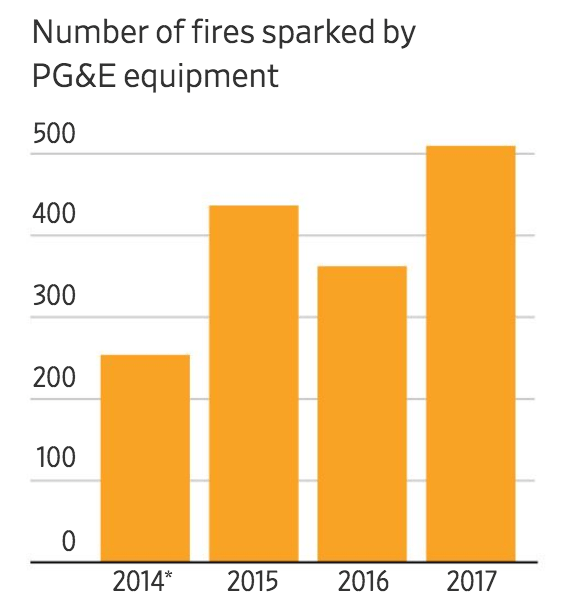
Leave a Reply
You must be logged in to post a comment.